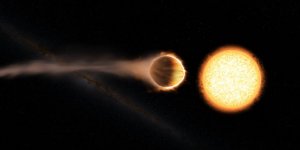| News / Space News |
Fresh Results from NASA’s Galileo Spacecraft 20 Years On
Far across the solar system, from where Earth appears merely as a pale blue dot, NASA’s Galileo spacecraft spent eight years orbiting Jupiter. The mission ended in 2003, but newly resurrected data from Galileo’s first flyby of Ganymede is yielding new insights about the moon’s environment — which is unlike any other in the solar system.

In this illustration, the moon Ganymede orbits the giant planet Jupiter. Ganymede is depicted with auroras, which were observed by NASA’s Hubble Space Telescope. Image credits: NASA/ESA
The new results showed a stormy scene: particles blasted off the moon’s icy surface as a result of incoming plasma rain, and strong flows of plasma pushed between Jupiter and Ganymede due to an explosive magnetic event occurring between the two bodies’ magnetic environments.
Scientists think these observations could be key to unlocking the secrets of the moon, such as why Ganymede’s auroras are so bright.
In 1996, shortly after arriving at Jupiter, Galileo made a surprising discovery: Ganymede had its own magnetic field. While most planets in our solar system, including Earth, have magnetic environments — known as magnetospheres — no one expected a moon to have one.
Ganymede’s magnetosphere offers the chance to explore a unique magnetic environment located within the much larger magnetosphere of Jupiter. Nestled there, it’s protected from the solar wind, making its shape different from other magnetospheres in the solar system.
Typically, magnetospheres are shaped by the pressure of supersonic solar wind particles flowing past them. But at Ganymede, the relatively slower-moving plasma around Jupiter sculpts the moon's magnetosphere into a long horn-like shape that stretches ahead of the moon in the direction of its orbit.
Ganymede has auroras, or northern and southern lights, just like Earth does. However, unlike our planet, the particles causing Ganymede’s auroras come from the plasma surrounding Jupiter, not the solar wind.
When analyzing the data, the scientists noticed that during its first Ganymede flyby, Galileo fortuitously crossed right over Ganymede’s auroral regions, as evidenced by the ions it observed raining down onto the surface of the moon’s polar cap.
By comparing the location where the falling ions were observed with data from Hubble, the scientists were able to pin down the precise location of the auroral zone, which will help them solve mysteries, such as what causes the auroras.
As it cruised around Jupiter, Galileo also happened to fly right through an explosive event caused by the tangling and snapping of magnetic field lines. This event, called magnetic reconnection, occurs in magnetospheres across our solar system.
For the first time, Galileo observed strong flows of plasma pushed between Jupiter and Ganymede due to a magnetic reconnection event occurring between the two magnetospheres. It’s thought that this plasma pump is responsible for making Ganymede’s auroras unusually bright. (NASA)
YOU MAY ALSO LIKE




